+ データを開く
データを開く
- 基本情報
基本情報
| 登録情報 | データベース: EMDB / ID: EMD-2971 | |||||||||
|---|---|---|---|---|---|---|---|---|---|---|
| タイトル | Structure and assembly of the mouse ASC filament | |||||||||
 マップデータ マップデータ | Reconstruction of ASC-PYD filament | |||||||||
 試料 試料 |
| |||||||||
 キーワード キーワード | ASC Apoptosis associated speck like protein containing a CARD / CARD caspase recruitment and activation domain / PYD PYRIN domain / PYHIN pyrin domain and hematopoietic expression / interferon inducibility / nuclear localization domain containing / NLR NOD like receptor / BIR Baculovirus IAP repeat domain | |||||||||
| 機能・相同性 |  機能・相同性情報 機能・相同性情報CLEC7A/inflammasome pathway / The NLRP3 inflammasome / Pyrin domain binding / NLRP6 inflammasome complex / myosin I binding / positive regulation of antigen processing and presentation of peptide antigen via MHC class II / myeloid dendritic cell activation involved in immune response / regulation of intrinsic apoptotic signaling pathway / peptidase activator activity involved in apoptotic process / IkappaB kinase complex ...CLEC7A/inflammasome pathway / The NLRP3 inflammasome / Pyrin domain binding / NLRP6 inflammasome complex / myosin I binding / positive regulation of antigen processing and presentation of peptide antigen via MHC class II / myeloid dendritic cell activation involved in immune response / regulation of intrinsic apoptotic signaling pathway / peptidase activator activity involved in apoptotic process / IkappaB kinase complex / AIM2 inflammasome complex / macropinocytosis / NLRP1 inflammasome complex / canonical inflammasome complex / interleukin-6 receptor binding / NLRP3 inflammasome complex assembly / BMP receptor binding / positive regulation of adaptive immune response / NLRP3 inflammasome complex / osmosensory signaling pathway / negative regulation of interferon-beta production / regulation of tumor necrosis factor-mediated signaling pathway / positive regulation of extrinsic apoptotic signaling pathway / pattern recognition receptor signaling pathway / regulation of GTPase activity / positive regulation of macrophage cytokine production / tropomyosin binding / pyroptotic inflammatory response / positive regulation of actin filament polymerization / positive regulation of release of cytochrome c from mitochondria / positive regulation of activated T cell proliferation / positive regulation of interleukin-10 production / cellular response to interleukin-1 / intrinsic apoptotic signaling pathway in response to DNA damage by p53 class mediator / positive regulation of T cell migration / positive regulation of chemokine production / positive regulation of defense response to virus by host / negative regulation of canonical NF-kappaB signal transduction / Neutrophil degranulation / negative regulation of cytokine production involved in inflammatory response / activation of innate immune response / positive regulation of phagocytosis / positive regulation of interleukin-1 beta production / tumor necrosis factor-mediated signaling pathway / positive regulation of interleukin-8 production / positive regulation of JNK cascade / response to bacterium / positive regulation of non-canonical NF-kappaB signal transduction / protein homooligomerization / regulation of protein stability / positive regulation of interleukin-6 production / positive regulation of type II interferon production / positive regulation of inflammatory response / positive regulation of tumor necrosis factor production / cellular response to lipopolysaccharide / regulation of inflammatory response / protease binding / regulation of apoptotic process / defense response to Gram-negative bacterium / defense response to virus / microtubule / transmembrane transporter binding / positive regulation of ERK1 and ERK2 cascade / positive regulation of canonical NF-kappaB signal transduction / protein dimerization activity / regulation of autophagy / defense response to Gram-positive bacterium / inflammatory response / Golgi membrane / innate immune response / neuronal cell body / apoptotic process / nucleolus / endoplasmic reticulum / protein homodimerization activity / mitochondrion / extracellular region / nucleoplasm / identical protein binding / nucleus / cytosol / cytoplasm 類似検索 - 分子機能 | |||||||||
| 生物種 |  | |||||||||
| 手法 | らせん対称体再構成法 / クライオ電子顕微鏡法 / 解像度: 4.0 Å | |||||||||
 データ登録者 データ登録者 | Sborgi L / Ravotti F / Dandey VP / Dick MS / Mazur A / Reckel S / Chami M / Scherer S / Bockmann A / Egelman EH ...Sborgi L / Ravotti F / Dandey VP / Dick MS / Mazur A / Reckel S / Chami M / Scherer S / Bockmann A / Egelman EH / Stahlberg H / Broz P / Meier BH / Hiller S | |||||||||
 引用 引用 |  ジャーナル: Proc Natl Acad Sci U S A / 年: 2015 ジャーナル: Proc Natl Acad Sci U S A / 年: 2015タイトル: Structure and assembly of the mouse ASC inflammasome by combined NMR spectroscopy and cryo-electron microscopy. 著者: Lorenzo Sborgi / Francesco Ravotti / Venkata P Dandey / Mathias S Dick / Adam Mazur / Sina Reckel / Mohamed Chami / Sebastian Scherer / Matthias Huber / Anja Böckmann / Edward H Egelman / ...著者: Lorenzo Sborgi / Francesco Ravotti / Venkata P Dandey / Mathias S Dick / Adam Mazur / Sina Reckel / Mohamed Chami / Sebastian Scherer / Matthias Huber / Anja Böckmann / Edward H Egelman / Henning Stahlberg / Petr Broz / Beat H Meier / Sebastian Hiller /    要旨: Inflammasomes are multiprotein complexes that control the innate immune response by activating caspase-1, thus promoting the secretion of cytokines in response to invading pathogens and endogenous ...Inflammasomes are multiprotein complexes that control the innate immune response by activating caspase-1, thus promoting the secretion of cytokines in response to invading pathogens and endogenous triggers. Assembly of inflammasomes is induced by activation of a receptor protein. Many inflammasome receptors require the adapter protein ASC [apoptosis-associated speck-like protein containing a caspase-recruitment domain (CARD)], which consists of two domains, the N-terminal pyrin domain (PYD) and the C-terminal CARD. Upon activation, ASC forms large oligomeric filaments, which facilitate procaspase-1 recruitment. Here, we characterize the structure and filament formation of mouse ASC in vitro at atomic resolution. Information from cryo-electron microscopy and solid-state NMR spectroscopy is combined in a single structure calculation to obtain the atomic-resolution structure of the ASC filament. Perturbations of NMR resonances upon filament formation monitor the specific binding interfaces of ASC-PYD association. Importantly, NMR experiments show the rigidity of the PYD forming the core of the filament as well as the high mobility of the CARD relative to this core. The findings are validated by structure-based mutagenesis experiments in cultured macrophages. The 3D structure of the mouse ASC-PYD filament is highly similar to the recently determined human ASC-PYD filament, suggesting evolutionary conservation of ASC-dependent inflammasome mechanisms. | |||||||||
| 履歴 |
|
- 構造の表示
構造の表示
| ムービー |
 ムービービューア ムービービューア |
|---|---|
| 構造ビューア | EMマップ:  SurfView SurfView Molmil Molmil Jmol/JSmol Jmol/JSmol |
| 添付画像 |
- ダウンロードとリンク
ダウンロードとリンク
-EMDBアーカイブ
| マップデータ |  emd_2971.map.gz emd_2971.map.gz | 6.9 MB |  EMDBマップデータ形式 EMDBマップデータ形式 | |
|---|---|---|---|---|
| ヘッダ (付随情報) |  emd-2971-v30.xml emd-2971-v30.xml emd-2971.xml emd-2971.xml | 10.1 KB 10.1 KB | 表示 表示 |  EMDBヘッダ EMDBヘッダ |
| 画像 |  emd_2971.jpg emd_2971.jpg | 1.9 MB | ||
| Filedesc structureFactors |  emd_2971_sf.cif.gz emd_2971_sf.cif.gz | 684.2 KB | ||
| アーカイブディレクトリ |  http://ftp.pdbj.org/pub/emdb/structures/EMD-2971 http://ftp.pdbj.org/pub/emdb/structures/EMD-2971 ftp://ftp.pdbj.org/pub/emdb/structures/EMD-2971 ftp://ftp.pdbj.org/pub/emdb/structures/EMD-2971 | HTTPS FTP |
-検証レポート
| 文書・要旨 |  emd_2971_validation.pdf.gz emd_2971_validation.pdf.gz | 368 KB | 表示 |  EMDB検証レポート EMDB検証レポート |
|---|---|---|---|---|
| 文書・詳細版 |  emd_2971_full_validation.pdf.gz emd_2971_full_validation.pdf.gz | 367.6 KB | 表示 | |
| XML形式データ |  emd_2971_validation.xml.gz emd_2971_validation.xml.gz | 4.8 KB | 表示 | |
| アーカイブディレクトリ |  https://ftp.pdbj.org/pub/emdb/validation_reports/EMD-2971 https://ftp.pdbj.org/pub/emdb/validation_reports/EMD-2971 ftp://ftp.pdbj.org/pub/emdb/validation_reports/EMD-2971 ftp://ftp.pdbj.org/pub/emdb/validation_reports/EMD-2971 | HTTPS FTP |
-関連構造データ
- リンク
リンク
| EMDBのページ |  EMDB (EBI/PDBe) / EMDB (EBI/PDBe) /  EMDataResource EMDataResource |
|---|---|
| 「今月の分子」の関連する項目 |
- マップ
マップ
| ファイル |  ダウンロード / ファイル: emd_2971.map.gz / 形式: CCP4 / 大きさ: 23.8 MB / タイプ: IMAGE STORED AS FLOATING POINT NUMBER (4 BYTES) ダウンロード / ファイル: emd_2971.map.gz / 形式: CCP4 / 大きさ: 23.8 MB / タイプ: IMAGE STORED AS FLOATING POINT NUMBER (4 BYTES) | ||||||||||||||||||||||||||||||||||||||||||||||||||||||||||||
|---|---|---|---|---|---|---|---|---|---|---|---|---|---|---|---|---|---|---|---|---|---|---|---|---|---|---|---|---|---|---|---|---|---|---|---|---|---|---|---|---|---|---|---|---|---|---|---|---|---|---|---|---|---|---|---|---|---|---|---|---|---|
| 注釈 | Reconstruction of ASC-PYD filament | ||||||||||||||||||||||||||||||||||||||||||||||||||||||||||||
| 投影像・断面図 | 画像のコントロール
画像は Spider により作成 これらの図は立方格子座標系で作成されたものです | ||||||||||||||||||||||||||||||||||||||||||||||||||||||||||||
| ボクセルのサイズ | X=Y=Z: 0.67 Å | ||||||||||||||||||||||||||||||||||||||||||||||||||||||||||||
| 密度 |
| ||||||||||||||||||||||||||||||||||||||||||||||||||||||||||||
| 対称性 | 空間群: 1 | ||||||||||||||||||||||||||||||||||||||||||||||||||||||||||||
| 詳細 | EMDB XML:
CCP4マップ ヘッダ情報:
| ||||||||||||||||||||||||||||||||||||||||||||||||||||||||||||
-添付データ
- 試料の構成要素
試料の構成要素
-全体 : Mouse ASC-PYD filament
| 全体 | 名称: Mouse ASC-PYD filament |
|---|---|
| 要素 |
|
-超分子 #1000: Mouse ASC-PYD filament
| 超分子 | 名称: Mouse ASC-PYD filament / タイプ: sample / ID: 1000 / Number unique components: 1 |
|---|
-分子 #1: mouse ASC filament
| 分子 | 名称: mouse ASC filament / タイプ: protein_or_peptide / ID: 1 / コピー数: 1 / 組換発現: Yes |
|---|---|
| 由来(天然) | 生物種:  |
| 組換発現 | 生物種:  |
-実験情報
-構造解析
| 手法 | クライオ電子顕微鏡法 |
|---|---|
 解析 解析 | らせん対称体再構成法 |
| 試料の集合状態 | filament |
- 試料調製
試料調製
| 緩衝液 | pH: 8 / 詳細: 25mM Tris 300mM NaCl |
|---|---|
| 凍結 | 凍結剤: ETHANE / 装置: FEI VITROBOT MARK IV 詳細: vitrified by plunging into liquid nitrogen-cooled liquid ethane 手法: The grids were blotted for 1 s before plunging |
- 電子顕微鏡法
電子顕微鏡法
| 顕微鏡 | FEI TITAN KRIOS |
|---|---|
| 日付 | 2014年10月10日 |
| 撮影 | カテゴリ: CCD フィルム・検出器のモデル: DIRECT ELECTRON DE-10 (5k x 4k) デジタル化 - サンプリング間隔: 5 µm / 実像数: 21138 / 平均電子線量: 20 e/Å2 |
| 電子線 | 加速電圧: 300 kV / 電子線源: TUNGSTEN HAIRPIN |
| 電子光学系 | 照射モード: SPOT SCAN / 撮影モード: DIFFRACTION / 倍率(公称値): 22500 |
| 試料ステージ | 試料ホルダーモデル: FEI TITAN KRIOS AUTOGRID HOLDER Tilt angle min: -12 / Tilt angle max: 12 |
| 実験機器 |  モデル: Titan Krios / 画像提供: FEI Company |
- 画像解析
画像解析
| 詳細 | The particles were aligned using IHRSR |
|---|---|
| 最終 再構成 | 想定した対称性 - らせんパラメータ - Δz: 14.2 Å 想定した対称性 - らせんパラメータ - ΔΦ: 53 ° 想定した対称性 - らせんパラメータ - 軸対称性: C3 (3回回転対称) アルゴリズム: OTHER / 解像度のタイプ: BY AUTHOR / 解像度: 4.0 Å / 解像度の算出法: OTHER / ソフトウェア - 名称: EMAN2, IHRSR, SPIDER |
| CTF補正 | 詳細: CTFFIND3 |
 ムービー
ムービー コントローラー
コントローラー



 UCSF Chimera
UCSF Chimera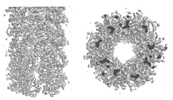


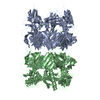

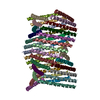



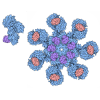

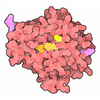









 Z (Sec.)
Z (Sec.) Y (Row.)
Y (Row.) X (Col.)
X (Col.)





















